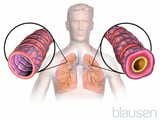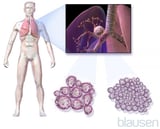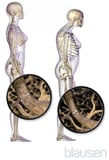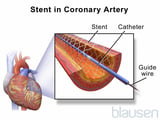Will Copd Continue to Worsen Over Age or Can I Arrest Its Effects
Chronic obstructive pulmonary disease is persistent narrowing (blocking, or obstruction) of the airways occurring with emphysema, chronic obstructive bronchitis, or both disorders.
-
Cigarette smoking is the most important cause of chronic obstructive pulmonary disease.
-
People develop a cough and eventually become short of breath.
-
Diagnosis is made with chest x-rays and tests of lung function.
-
Stopping smoking and taking drugs that help keep airways open are important.
-
People who have severe disease may need to take other drugs, use oxygen, have pulmonary rehabilitation, or rarely lung volume reduction surgery.
In the United States, about 16 million people have chronic obstructive pulmonary disease (COPD). It is a common cause of death, accounting for more than 150,000 each year.
Worldwide, the number of people with COPD is increasing. Factors contributing to COPD include an increase in smoking in many countries and, throughout the world, exposure to toxins in biomass fuels such as wood and grasses. Death rates may be increasing in medically underserved countries. By 2030, COPD is projected to become the third leading cause of death worldwide.
COPD leads to a persistent decrease in the rate of airflow from the lungs when the person breathes out (exhales), which is called chronic airflow obstruction. COPD includes the diagnoses of chronic obstructive bronchitis and emphysema. Many people have both disorders.
-
Chronic bronchitis is defined as cough that produces sputum for at least 3 months during two successive years. When chronic bronchitis involves airflow obstruction, it qualifies as chronic obstructive bronchitis.
-
Emphysema is defined as widespread and irreversible destruction of the alveolar walls (the cells that support the air sacs, or alveoli, that make up the lungs) and enlargement of many of the alveoli.
The small airways (bronchioles) of the lungs contain smooth muscles and are normally held open by their attachments to alveolar walls. In emphysema, the destruction of alveolar wall attachments results in collapse of the bronchioles when a person exhales, causing airflow obstruction that is permanent and irreversible. In chronic bronchitis, the glands lining the larger airways (bronchi) of the lungs enlarge and increase their secretion of mucus. Inflammation of the bronchioles develops and causes smooth muscles in lung tissue to contract (spasm), further obstructing airflow. Inflammation also causes swelling of the airway passages and secretions in them, further limiting airflow. Eventually, the small airways in the lung become narrowed and destroyed. Asthma Asthma Asthma is a condition in which the airways narrow—usually reversibly—in response to certain stimuli. Coughing, wheezing, and shortness of breath that occur in response to specific triggers are... read more  is also characterized by airflow obstruction. However, unlike airflow obstruction in COPD, airflow obstruction in asthma is completely reversible in most people, either spontaneously or with treatment.
is also characterized by airflow obstruction. However, unlike airflow obstruction in COPD, airflow obstruction in asthma is completely reversible in most people, either spontaneously or with treatment.
The COVID-19 pandemic has posed a particular risk to people with COPD. Having COPD increased a person's risk of being hospitalized or dying from COVID-19. Overall, however, people with COPD were hospitalized less often during the COVID-19 pandemic than before. Increased precautions against respiratory infection (for example, masks, social distancing) are thought to be why people with COPD were hospitalized less. Also, people with symptoms, such as an acute exacerbation of COPD, may have avoided their local emergency department out of fear of contracting COVID-19.
The most important cause of COPD is
-
Cigarette smoking
Only about 15% of smokers develop COPD. With aging, susceptible cigarette smokers lose lung function more rapidly than nonsmokers. Lung function improves only a little if people stop smoking. However, the rate of decline of lung function returns to that of nonsmokers when people stop smoking, thus delaying development and progression of symptoms. Pipe and cigar smokers develop COPD more often than nonsmokers but not as often as cigarette smokers. It is not clear whether smoking marijuana contributes to COPD.
COPD tends to occur more often in some families, so there may be an inherited tendency in some people.
COPD takes years to develop and progress.
In people with COPD, a mild cough that produces clear sputum develops during their 40s or 50s. The cough and sputum production are usually worse when the person first gets out of bed in the morning. Cough and sputum production can persist throughout the day.
By the time people with COPD reach their middle to late 60s, especially if they continue smoking, shortness of breath during exertion becomes more troublesome.
About one third of people with severe COPD experience severe weight loss. The cause of weight loss is not clear, and causes may differ among different people. Possible causes include shortness of breath that makes eating difficult and increased levels in the blood of a substance called tumor necrosis factor.
Morning headaches may occur because breathing decreases during sleep, which causes increased retention of carbon dioxide and decreased levels of oxygen in the blood.
As COPD progresses, some people, especially those who have emphysema, develop unusual breathing patterns. Some people breathe out through pursed lips. Others find it more comfortable to stand over a table with their arms outstretched and their weight on their palms or elbows, a maneuver that improves the function of some of the respiratory muscles.
A flare-up (or exacerbation) of COPD is a worsening of symptoms, usually cough, increased sputum, and shortness of breath. Sputum color often changes to yellow or green, and fever and body aches sometimes occur. Shortness of breath may be present when the person is at rest and may be severe enough to require hospitalization. Severe air pollution, common allergens, and viral or bacterial infections may cause flare-ups.
People with COPD also have an increased risk of developing heart rhythm abnormalities Overview of Abnormal Heart Rhythms Abnormal heart rhythms (arrhythmias) are sequences of heartbeats that are irregular, too fast, too slow, or conducted via an abnormal electrical pathway through the heart. Heart disorders are... read more  (arrhythmias). People with COPD who smoke have a higher risk of developing lung cancer Lung Cancer Lung cancer is the leading cause of cancer death in both men and women. About 85% of cases are related to cigarette smoking. One common symptom is a persistent cough or a change in the character... read more
(arrhythmias). People with COPD who smoke have a higher risk of developing lung cancer Lung Cancer Lung cancer is the leading cause of cancer death in both men and women. About 85% of cases are related to cigarette smoking. One common symptom is a persistent cough or a change in the character... read more  than do people who do not have COPD but smoke the same amount. People with COPD seem to have an increased risk of developing osteoporosis Osteoporosis Osteoporosis is a condition in which a decrease in the density of bones weakens the bones, making breaks (fractures) likely. Aging, estrogen deficiency, low vitamin D or calcium intake, and... read more
than do people who do not have COPD but smoke the same amount. People with COPD seem to have an increased risk of developing osteoporosis Osteoporosis Osteoporosis is a condition in which a decrease in the density of bones weakens the bones, making breaks (fractures) likely. Aging, estrogen deficiency, low vitamin D or calcium intake, and... read more  , depression Depression A short discussion of prolonged grief disorder. Depression is a feeling of sadness and/or a decreased interest or pleasure in activities that becomes a disorder when it is intense enough to... read more , coronary artery disease Overview of Coronary Artery Disease (CAD) Coronary artery disease is a condition in which the blood supply to the heart muscle is partially or completely blocked. The heart muscle needs a constant supply of oxygen-rich blood. The coronary... read more
, depression Depression A short discussion of prolonged grief disorder. Depression is a feeling of sadness and/or a decreased interest or pleasure in activities that becomes a disorder when it is intense enough to... read more , coronary artery disease Overview of Coronary Artery Disease (CAD) Coronary artery disease is a condition in which the blood supply to the heart muscle is partially or completely blocked. The heart muscle needs a constant supply of oxygen-rich blood. The coronary... read more  , muscle wasting (atrophy), and gastroesophageal reflux Gastroesophageal Reflux Disease (GERD) In gastroesophageal reflux disease, stomach contents, including acid and bile, flow backward from the stomach into the esophagus, causing inflammation in the esophagus and pain in the bottom... read more
, muscle wasting (atrophy), and gastroesophageal reflux Gastroesophageal Reflux Disease (GERD) In gastroesophageal reflux disease, stomach contents, including acid and bile, flow backward from the stomach into the esophagus, causing inflammation in the esophagus and pain in the bottom... read more  . However, it is not clear whether the risk is increased because of COPD or other factors.
. However, it is not clear whether the risk is increased because of COPD or other factors.
-
Chest x-rays
-
Tests of lung function
Doctors diagnose chronic bronchitis based on the person's history of a prolonged productive cough for at least 3 months during 2 consecutive years after excluding other causes of chronic cough.
Emphysema is diagnosed on the basis of findings observed during a physical examination and on pulmonary function test results. However, by the time the doctor notices these abnormalities, emphysema is moderately severe. Findings on a chest x-ray or computed tomography (CT) of the chest may also help in diagnosis of emphysema and sometimes chronic bronchitis. It is not important for doctors to differentiate between chronic bronchitis and emphysema, and often chronic bronchitis and emphysema occur together in the same person. The most important determinant of how the person feels and functions is the severity of the airflow obstruction.
In mild COPD, doctors may find nothing unusual during the physical examination. As the disease progresses, doctors may hear wheezing or notice a decrease in the normal sounds of breathing (decreased breath sounds) when they listen to the lungs with a stethoscope. Doctors may note that it takes a long time for the person to exhale air that has been inhaled (prolonged expiration). Chest movement diminishes during breathing, and the person may use the neck and shoulder muscles to breathe.
In mild COPD, the chest x-ray is usually normal. As COPD worsens, the chest x-ray shows that the lungs contain excess air (over-inflation of the lungs). Over-inflation, thinning of blood vessels, or the presence of cysts in the lungs (called bullae) suggests the presence of emphysema.
Doctors may do other tests to detect other disorders that could be causing the person's symptoms.
When people have a COPD flare-up, doctors often use blood gas measurements to determine how much oxygen and carbon dioxide are in the person's blood. Doctors may do a chest x-ray to look for evidence of a lung infection. If they suspect a lung infection, particularly if the flare-up is severe enough that the person is being treated in the hospital, doctors will do additional tests to identify the virus or bacterium causing the flare-up because treatment depends on which organism is responsible.
-
Smoking cessation
-
Relief of symptoms (for example, with drugs)
-
Supportive care (for example, pulmonary rehabilitation, a nutritious diet)
The most important treatment for COPD is to stop smoking Smoking Cessation While often very challenging, quitting smoking is one of the most important things smokers can do for their health. Quitting smoking brings immediate health benefits that increase over time... read more . Stopping smoking when the airflow obstruction is mild or moderate often lessens cough, reduces the amount of sputum, and slows the development of shortness of breath. Stopping smoking at any point in the disease process provides some benefit. Trying several strategies at once is most likely to be effective. Among these strategies are committing to a specific date for quitting, using behavioral modification techniques (for example, making cigarettes difficult to obtain or rewarding oneself for abstaining for increasingly long periods of time), group counseling and support sessions, and nicotine replacement (for example, by chewing nicotine gum, wearing a nicotine skin patch, or using a nicotine inhaler, nicotine lozenge, or nicotine nasal spray). The drugs varenicline and bupropion may also help decrease tobacco craving. However, even with the most effective methods, less than half of people who try have quit smoking after one year.
People should also try to avoid exposure to other airborne irritants, including secondhand smoke and air pollution.
Because COPD can cause severe weight loss, people should eat a balanced, nutritious diet.
Wheezing and shortness of breath are relieved when airflow obstruction decreases. Although airflow obstruction due to emphysema is not reversible, bronchial smooth muscle spasm, inflammation, and increased secretions are all potentially reversible.
Inhaled bronchodilators are given with a device that allows the user to spray a specific and consistent dose of a drug into the airways via the mouth and throat (inhalers, including metered-dose inhalers and dry-powder inhalers). Inhaled bronchodilators include
-
Anticholinergic drugs
-
Beta-adrenergic drugs
Both anticholinergic and beta-adrenergic drugs relax muscles around the bronchioles.
Anticholinergic drugs include ipratropium, umeclidinium, aclidinium, revefenacin, and tiotropium. Ipratropium is given about 4 times daily, aclidinium is given twice per day, and tiotropium, revefenacin, and umeclidinium are given once per day.
Inhaled short-acting beta-adrenergic drugs, such as albuterol, more rapidly relieve shortness of breath than anticholinergic drugs and so can be most useful during flare-ups. Salmeterol, formoterol, arformoterol, vilanterol, olodaterol, and indacaterol are long-acting beta-adrenergic drugs. Salmeterol, arformoterol, and formoterol are given every 12 hours. Indacaterol, olodaterol, and vilanterol are given once a day. Umeclidinium and vilanterol are available as an inhaled formulation that combines both drugs. Olodaterol is also available in combination with tiotropium. Long-acting beta-adrenergic drugs are useful for prolonged relief of symptoms in some people, especially at night, but they should not be used for rapid relief of symptoms.
Anticholinergic and beta-adrenergic drugs are available in combination. Glycopyrrolate is an anticholinergic drug available in combination with the long-acting beta-adrenergic drugs formoterol or indacaterol.
Many people can use metered-dose inhalers more effectively when they inhale the drug through a delivery device called a spacer (see figure How to Use a Metered-Dose Inhaler How to Use a Metered-Dose Inhaler  ). Inhaled bronchodilators may also be given using nebulizers. This mode of therapy should be reserved for people who have severe disease or for those who cannot use a metered-dose inhaler properly. A nebulizer creates a mist of drug, and the timing of its inhalation does not have to be coordinated with breathing. Nebulizers are portable, and some units can even be plugged into the accessory socket in a car.
). Inhaled bronchodilators may also be given using nebulizers. This mode of therapy should be reserved for people who have severe disease or for those who cannot use a metered-dose inhaler properly. A nebulizer creates a mist of drug, and the timing of its inhalation does not have to be coordinated with breathing. Nebulizers are portable, and some units can even be plugged into the accessory socket in a car.
Corticosteroids are helpful for many people with moderate and severe COPD whose symptoms cannot be controlled by the other drugs or for those who get frequent flare-ups despite the use of other drugs. Inhaled corticosteroids do not prevent decline of lung function over time. However, their use decreases symptoms and the frequency of COPD flare-ups. Because the drug is delivered to the lungs, typical doses of inhaled corticosteroids cause fewer side effects than corticosteroid treatment given by mouth. However, high doses of inhaled corticosteroids can have effects throughout the body, such as worsening of osteoporosis Osteoporosis Osteoporosis is a condition in which a decrease in the density of bones weakens the bones, making breaks (fractures) likely. Aging, estrogen deficiency, low vitamin D or calcium intake, and... read more  , particularly in older people. Corticosteroids given by mouth are largely restricted to treatment of COPD flare-ups or are given to people who have periodic flare-ups or continue to have symptoms due to airflow obstruction and who are not responding to a simpler regimen.
, particularly in older people. Corticosteroids given by mouth are largely restricted to treatment of COPD flare-ups or are given to people who have periodic flare-ups or continue to have symptoms due to airflow obstruction and who are not responding to a simpler regimen.
Phosphodiesterase 4 inhibitors, such as roflumilast, reduce inflammation and widen the airways. Phosphodiesterase 4 inhibitors can be used together with other bronchodilators to reduce the risk of COPD flare-ups. Common side effects include nausea, headache, and weight loss, but these effects may decline with continued use of the drugs.
Taking the antibiotic azithromycin or erythromycin long term may help prevent flares of COPD, particularly among people prone to frequent or severe flares and who do not smoke.
Theophylline is given infrequently, only to people who do not respond to other drugs. The dose must be carefully controlled by the doctor, and, in some people, levels of the drug in the blood must be measured periodically. A long-acting form of the drug permits once-daily or twice-daily dosing in many people and helps to control shortness of breath at night.
Doctors used to give drugs (expectorants) to help thin secretions and make them easier to cough up. However, there is no good evidence that these drugs work. However, avoiding dehydration may prevent thickening of secretions. A rule of thumb is to drink enough fluids to keep the urine pale except for that passed first in the morning.
Pulse oximetry is often used to monitor symptoms. Taking a sample of blood from an artery or vein and measuring the amount of oxygen and carbon dioxide in the blood can provide additional information that is useful in monitoring severe disease.
Flare-ups should be treated as soon as possible. When bacterial infection is suspected, a 7- to 10-day course of antibiotic treatment is usually prescribed. Many doctors give people who have COPD a supply of an antibiotic to be kept on hand and taken early in a flare-up. A number of antibiotics can be taken by mouth, including trimethoprim/sulfamethoxazole, doxycycline, amoxicillin/clavulanate, and ampicillin. Many doctors reserve certain antibiotics, such as azithromycin, clarithromycin, and levofloxacin, for people with more severe lung infections, people in whom treatment with older drugs has not worked, people who have severe symptoms, and people at risk of infection with organisms that are not likely to be eliminated by older drugs (resistant bacteria). People whose immune system is suppressed or those who live in nursing homes are most likely to be infected with resistant bacteria.
Some people with severe disease or frequent flare-ups benefit from taking antibiotics long-term. Commonly given antibiotics include azithromycin, clarithromycin, or erythromycin. However, long-term antibiotic use may not be possible or recommended because of troublesome side effects or because long-term use may make bacteria resistant to the antibiotic's effects.
Different devices are available for oxygen therapy. Electrically driven oxygen concentrators are used when electrical outlets are available. Compressed oxygen is available in small tanks that permit people to travel outside of their homes for 2 to 6 hours. Liquid oxygen systems are more expensive but are preferable for active people as they permit several hours away from the source reservoir. Battery-driven portable oxygen concentrators are another option and can be used while travelling on commercial airplanes. People must never use oxygen therapy near open flames or while smoking.
Pulmonary rehabilitation Pulmonary Rehabilitation Pulmonary rehabilitation is the use of supervised exercise, education, support, and behavioral intervention to improve how people with chronic lung disease function in daily life and to enhance... read more can help people who have COPD, but it does not improve lung function. Programs encompass education about the disease, exercise, and nutritional and psychosocial counseling. These programs can improve independence and quality of life, decrease the frequency and length of hospital stays, and improve the ability to exercise. Exercise programs can be carried out in an outpatient treatment facility or at home. Walking (sometimes on a treadmill) is usually used to exercise the legs. Sometimes stationary bicycling and stair climbing are also used. Weight lifting is used for the arms. Often, oxygen is recommended during exercise. As with any exercise program, gains in conditioning are quickly lost if the person stops exercising. Special techniques are taught for decreasing shortness of breath during activities, such as cooking, engaging in hobbies, and sexual activity.
Over-the-counter cough suppressants are usually of no help and are not recommended.
Opioids are sometimes used to relieve severe coughing spells or pain but should be avoided when possible because they can cause drowsiness and constipation, suppress cough (which can cause or worsen infection) and, if used regularly, can cause dependence or addiction.
Lung volume reduction surgery can be carried out in people with severe emphysema in the upper portions of their lungs. The goal is to improve exercise ability and quality of life. In this operation, the most severely diseased portions of the lungs are removed, thus permitting the remaining portions of the lungs and the diaphragm to function better. The improvement lasts for at least several years. People are required to stop smoking for at least 6 months before surgery. They should undergo an intense rehabilitation program to determine whether overall function can be improved significantly without surgery before undertaking this operation, which carries a risk of death of about 5%.
Valves can be placed inside parts of the airways to block them off (called endobronchial valves). Doing so helps only selected people who have COPD. To place these valves, the doctor uses a flexible viewing tube.
COPD itself usually does not cause death or severe symptoms if the person stops smoking at a time when airflow is only mildly obstructed. Continued smoking, however, virtually assures that symptoms will worsen. With moderate and severe airflow obstruction, the prognosis becomes progressively worse.
People in advanced stages of COPD are likely to need considerable help with medical care and with activities of daily living. They may, for example, arrange to live on a single floor of their house, eat several small meals each day rather than one large one, and avoid wearing shoes that must be tied.
Death may result from respiratory failure, lung cancer, heart disorders (for example, heart failure or heart rhythm abnormalities), pneumonia, pneumothorax, or blockage of the arteries leading to the lungs (pulmonary embolism).
People with end-stage disease who develop flare-ups may need a breathing tube and mechanical ventilation. The duration of mechanical ventilation may be prolonged, and some people remain ventilator-dependent until death. It is important for people to consider with their doctors and loved ones whether or not they wish this kind of supportive therapy and to do so before a flare-up occurs.
The following are some English-language resources that may be useful. Please note that THE MANUAL is not responsible for the content of these resources.
-
COPD Foundation: Includes information on COPD diagnosis and treatment and tools to support people with COPD and their caregivers
Source: https://www.msdmanuals.com/home/lung-and-airway-disorders/chronic-obstructive-pulmonary-disease-copd/chronic-obstructive-pulmonary-disease-copd
0 Response to "Will Copd Continue to Worsen Over Age or Can I Arrest Its Effects"
Post a Comment